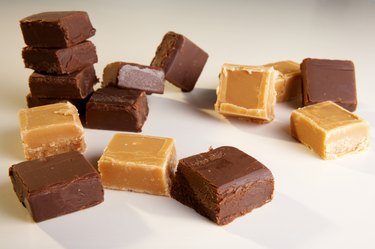
Fudge seems simple enough. After all, people have been making it for generations. If yours is greasy on the top, the probable cause is overcooking or stirring. Use a slow, gentle approach and make sure your ingredients are at room temperature. If possible, make fudge on a dry day. Moisture -- and even humidity in the air -- can cause problems.
The Problem
Video of the Day
Fudge is an emulsion -- the blending of two seemingly incompatible ingredients, sugar and butter -- to make a creamy product. Greasy fudge indicates that the fat solids have separated from the liquid and the sugar.
Video of the Day
Watch the Heat
Fudge separates, becoming grainy and greasy, if the temperature of the milk and sugar rises above 234 degrees Fahrenheit. To ensure this doesn't happen, use a candy thermometer. The traditional-style thermometers tend to be more accurate than dial thermometers. Attach the thermometer to the side of the pan, making sure its base doesn't touch the bottom of the pan. Bend down to read the thermometer at eye level, and pull the sugar mixture off the stove as soon as it reaches 234 F. At this temperature, it will be slightly golden-brown. At high altitude, reduce the temperature by 2 degrees for each 1,000 feet you live above sea level. For example, cook the fudge to 224 F if you live 5,000 feet above sea level.
Put Down the Spoon
Some recipes suggest stirring the sugar-milk mixture constantly until it reaches 234 F. This vigorous stirring can cause the mixture to curdle or break, which can result in greasy fudge. Spray a wooden spoon with nonstick spray before you begin. Stir the sugar-milk mixture constantly to bring it to a boil. At this point, turn off the heat, cover the pan and allow it to sit for 30 minutes. This resting period ensures the sugar has dissolved completely so you get a creamier fudge. Once the sugar has completely dissolved, bring the mixture to a boil again, but this time, do not stir it at all. Allow it to reach the correct temperature and remove it from the heat. This gentle approach should eliminate most problems with greasiness.
The Right Ingredients
The ingredients you use -- and how you store them -- can also play a role in fudge-making success. Use regular evaporated milk, rather than low-fat or nonfat, which are more likely to separate when heated. A pinch of cream of tartar added to the sugar and milk mixture can help reduce graininess. Cut the butter in cubes and add it to the sugar-milk mixture after you've boiled it. Cooking the butter with the sugar and milk can break down the milk solids in the butter, causing greasiness. Finally, don't store the butter or chocolate in the freezer. Moisture condensation from the freezer can add water to the fudge, causing seizing and separating.